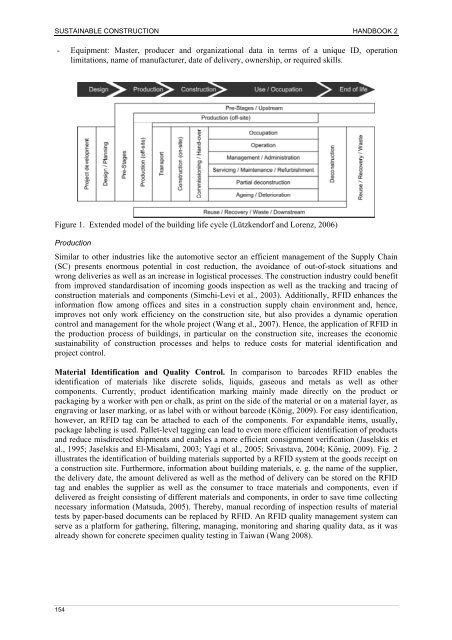Industrialised, Integrated, Intelligent sustainable Construction - I3con
Industrialised, Integrated, Intelligent sustainable Construction - I3con
Industrialised, Integrated, Intelligent sustainable Construction - I3con
Create successful ePaper yourself
Turn your PDF publications into a flip-book with our unique Google optimized e-Paper software.
SUSTAINABLE CONSTRUCTION HANDBOOK 2<br />
- Equipment: Master, producer and organizational data in terms of a unique ID, operation<br />
limitations, name of manufacturer, date of delivery, ownership, or required skills.<br />
Figure 1. Extended model of the building life cycle (Lützkendorf and Lorenz, 2006)<br />
Production<br />
Similar to other industries like the automotive sector an efficient management of the Supply Chain<br />
(SC) presents enormous potential in cost reduction, the avoidance of out-of-stock situations and<br />
wrong deliveries as well as an increase in logistical processes. The construction industry could benefit<br />
from improved standardisation of incoming goods inspection as well as the tracking and tracing of<br />
construction materials and components (Simchi-Levi et al., 2003). Additionally, RFID enhances the<br />
information flow among offices and sites in a construction supply chain environment and, hence,<br />
improves not only work efficiency on the construction site, but also provides a dynamic operation<br />
control and management for the whole project (Wang et al., 2007). Hence, the application of RFID in<br />
the production process of buildings, in particular on the construction site, increases the economic<br />
sustainability of construction processes and helps to reduce costs for material identification and<br />
project control.<br />
Material Identification and Quality Control. In comparison to barcodes RFID enables the<br />
identification of materials like discrete solids, liquids, gaseous and metals as well as other<br />
components. Currently, product identification marking mainly made directly on the product or<br />
packaging by a worker with pen or chalk, as print on the side of the material or on a material layer, as<br />
engraving or laser marking, or as label with or without barcode (König, 2009). For easy identification,<br />
however, an RFID tag can be attached to each of the components. For expandable items, usually,<br />
package labeling is used. Pallet-level tagging can lead to even more efficient identification of products<br />
and reduce misdirected shipments and enables a more efficient consignment verification (Jaselskis et<br />
al., 1995; Jaselskis and El-Misalami, 2003; Yagi et al., 2005; Srivastava, 2004; König, 2009). Fig. 2<br />
illustrates the identification of building materials supported by a RFID system at the goods receipt on<br />
a construction site. Furthermore, information about building materials, e. g. the name of the supplier,<br />
the delivery date, the amount delivered as well as the method of delivery can be stored on the RFID<br />
tag and enables the supplier as well as the consumer to trace materials and components, even if<br />
delivered as freight consisting of different materials and components, in order to save time collecting<br />
necessary information (Matsuda, 2005). Thereby, manual recording of inspection results of material<br />
tests by paper-based documents can be replaced by RFID. An RFID quality management system can<br />
serve as a platform for gathering, filtering, managing, monitoring and sharing quality data, as it was<br />
already shown for concrete specimen quality testing in Taiwan (Wang 2008).<br />
154






